The amount of steel packaging in 2017 was 480.000 tons, and apart from a few economic oscillations, like those caused by the 2008 economic crisis, the trend of marketed steel has remained quite stable. The types of steel packaging have changed with the passing of time, and the decrease of material released to consumption mostly concerned General Line packaging – cans, buckets and kegs used in the varnish, paint, enamel and oil industries – Open top and crown lids, whilst the production of capsules and kegs and cages for small cisterns have increased.
Even though only 4% of the total steel is destined to packaging, the recycling market of this material managed to grow (with the help of Ricrea) through the involvement of all the actors who belong to this industry: from municipalities and their delegates, to selection platforms, waste operators, all the way to the final recyclers, steel mills and foundries.
The shift from a linear model to a circular model is therefore partially integrated to the industry, and the new targets placed by European directives are now accessible, if not already accomplished (70% by 2025 and 80% by 2030).
Let’s not forget that approximately 6 million tons of steel packaging were recycled from 2000 to 2017, going from 153,000 to 361,000 tons, i.e. from 25.5% in 2000 to 75.3% in 2017.
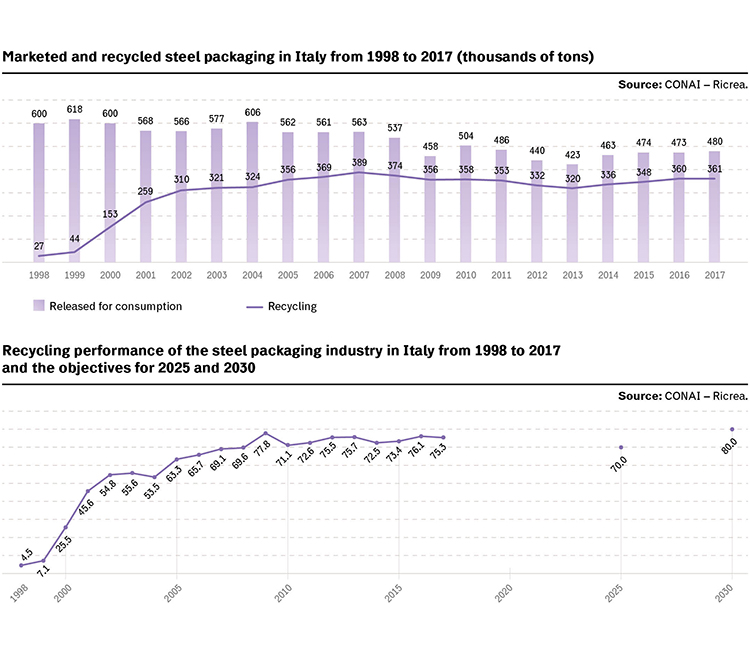
The CAC (CONAI Environmental Contribution), is one of the Consortium’s financial instruments in addition to the income from material transfer, this instrument has a great strategic and competitive importance when selecting the material used to package a product.
The Consortium’s income has increased in 2017 mostly thanks to the significant increase of material transfers, and this positive increase has allowed to reduce the CAC even further, reaching 8 euros/ton in 2018, the lowest value since the institution of Ricrea. The trend is now constantly decreasing, going from 31 euros/ton in 2016, 26 euros/ton in 2012, 21 euro/ton in April of 2015, 13 euro/ton in October of 2015 reaching the current figure of 8 euros/ton.
2017 was also the first year where revenue from material sales was higher than the income from the environmental contribution.
The challenge is to continue tackling the lower income caused by the reduction of the CAC and ensure a greater commitment towards municipalities that must be rewarded for the collection of packaging in order to improve results.
New directives establish the definition of a new recycling point at the beginning of the final recycling process, creating the necessity of an all-round management of the flows at the base of collection, which should be opportunely analysed.
Ricrea is the coordinator in the current model of packaging waste management: the processing (exploitation) of materials must be carried out by the companies tasked with the retrieval of metal and withdrawal of the material made available at storage/selection platforms, these companies then send the material to the final recycling process at steel mills or foundries.
Ricrea has activated a new sales channel in 2014, handing over a part of the material directly to steel mills rather than operators (through the stipulation of direct contracts): part of the material gathered from public areas is processed directly on platforms equipped with specific machinery (small grinding mills) that produce material which can be used in steel mills, skipping the step that involves collection operators.
The first applications of this model have been activated in Sardinia and Sicily in 2015, where a part of the material is sent directly from the selection platform equipped with a grinding mill to the steel mill.
This model entails a series of positive effects on economic, environmental and material quality aspects.
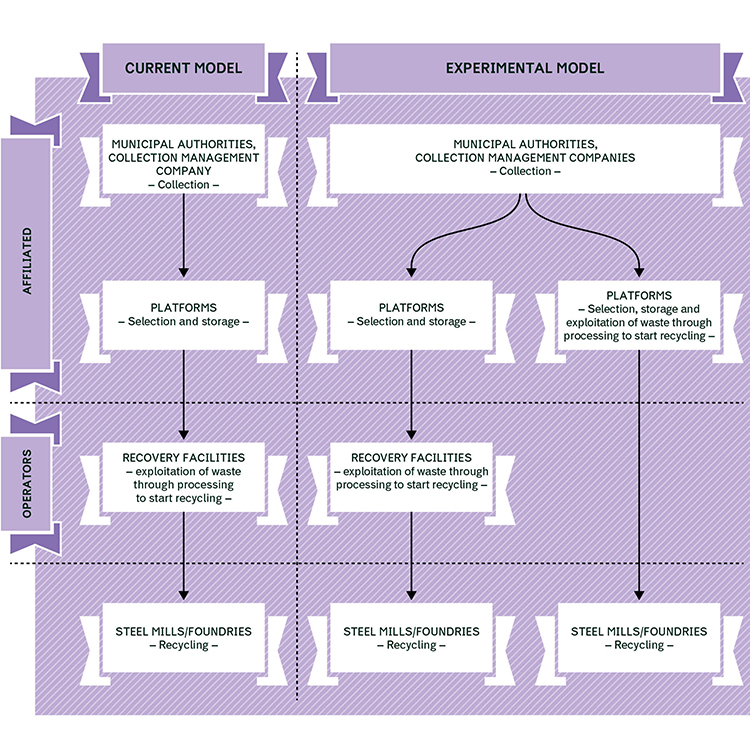
Optimisation of material logistics, with positive environmental and economic repercussions:
- processing and recycling waste locally, directly in steel mills (effectively skipping a step) is a logistic and economic optimisation, especially when the costs of transport are elevated (like in the case of the two largest islands).
- A greater margin on the revenue from material divestments compared to traditional sales, allowing the reduction of CAC, making steel packaging even more competitive on the market;
- Revenue for the contribution towards exploitation is given directly to municipalities/affiliates, effectively increasing the quality and quantity of materials.
In order to be updated on the advancements of the steel packaging sector, the consortium has solidified various partnership with universities and research bodies in the last few years. These are the latest projects that will be developed and presented during 2018:
“Properties and presentations of metal packaging: life cycle, recovery and reuse”, entrusted to the Politecnico di Milano- Mechanics Department.
“Environmental sustainability of steel used as food-packaging combined with an experimental activity aimed at comparing the protective efficiency of different packaging material in the preservation of sensory characteristics of various types of vegetable oils”, entrusted to the Bra University of Food Sciences.
The most important critical issues for the full application of circular economy in Italy are bound to the steel market as well as separate waste collection:
- Current technology allows only part of steel products to be made from recycled steel: plain laminates are produced only through integral cycle (where the main supplies come from the iron and coal mineral used in blast furnaces), with very few exceptions. The future global challenge will be to drastically reduce use of blast furnaces for the production of steel (energy intensive and environmentally impactful) in favour of renewable sources.
- Steel packaging is almost always collected with other materials like plastic and glass, the separation of these materials may sometimes represent a critical factor due to the presence of extraneous fractions within the extracted waste. This factor generates:
– Acceptance issues for the material at the final operator.
– The profitability of the industry could be compromised by the continuous increase of disposal costs.
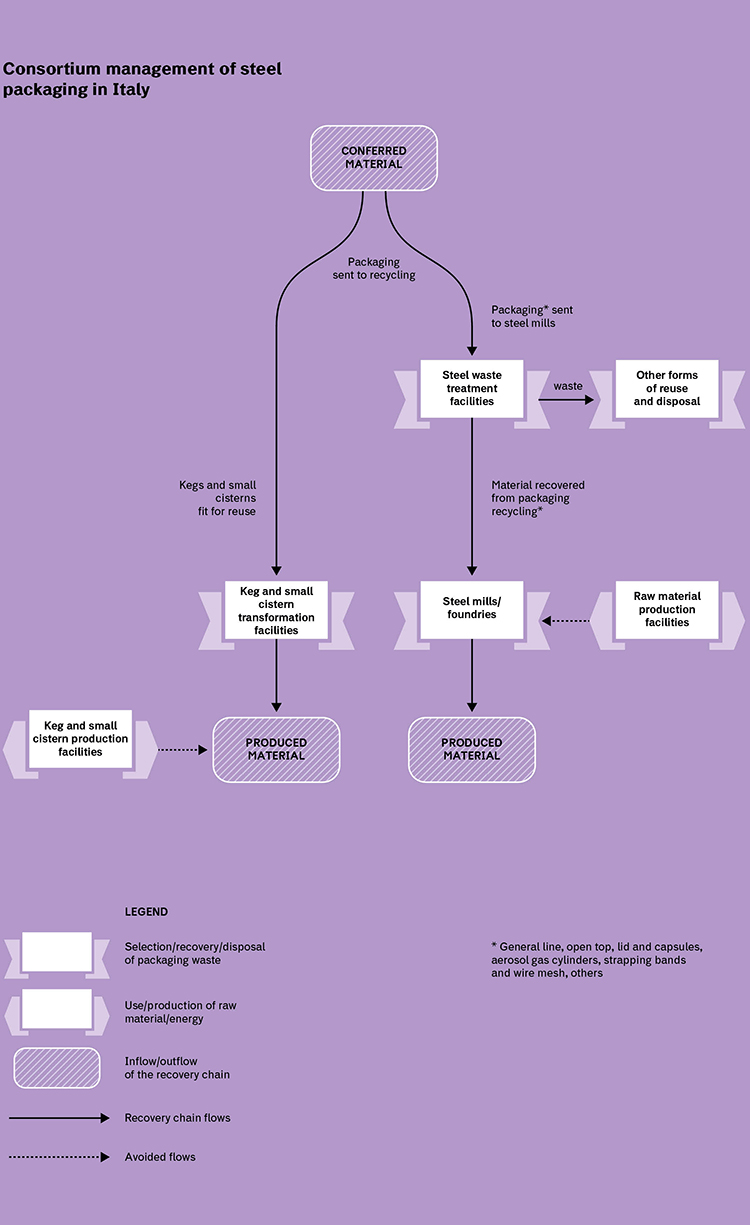
The environmental and socio-economic benefits of consortium management
Ricrea handled the recycling of 193,000 tons (54%) of the total 361,000 tons of steel packaging waste recycled and recovered in 2017.
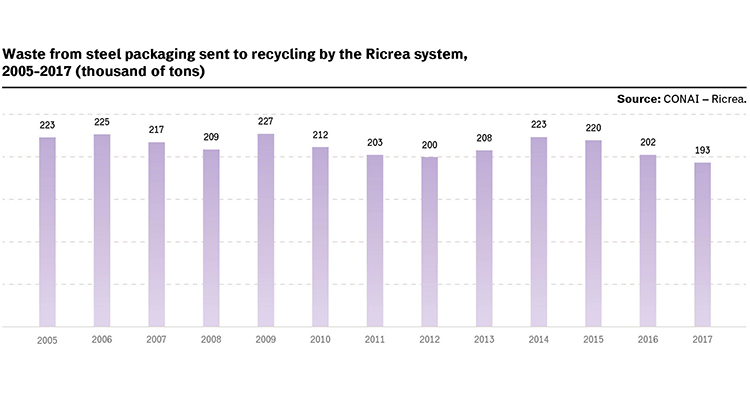
The quantity of material recycled and recovered by the consortium between 2005 and 2017 show an unsteady progression, the peak was reached in 2009 with 227,000, and the lowest figure was reached last year, with 200,000. This progression can be attributed to various factors, mainly to macro-economic developments and their influence on material released for consumption, but there is more. Specifically, the three-year period between 2015 and 2017 shows a decreasing trend; in this case it was largely caused by the increase of impurities and the Similar Product Fraction present in the collected waste. In fact, the quantity of packaging waste recycled by Ricrea is determined by subtracting the impurity quota and Similar Product Fraction obtained through specific product analysis. The causes are many, and not all of them are negative. For example the growth of national coverage that brought the inclusion of areas where separate waste collection ratios are still low, the stipulation of conventions for the selection of mixed waste (with very high percentages of impurity, typical of this type of waste), selection of machinery by operators that witnessed the improvement of selection performance of some materials to the detriment of others.
According to CONAI LLC Tool results, the recycling of steel packaging coming from separate and mixed waste collection from public areas and the regeneration of kegs and small cisterns from private areas carried out by Ricrea from 2005 to 2017, avoided the consumption of more than 3 million tons of raw material in Italy, the equivalent weight of more than 8,000 Frecciarossa ETE1000 trains. The trends of saved material are parallel to the quantity of recycling and regeneration, showing an equally unsteady development.
In 2017, the Ricrea consortium managed to prevent the consumption of 241,000 tons of raw material thanks to the recycling of steel packaging.
On the whole, the activities carried out by the Consortium between 2005 and 2017 allowed out country to avoid consuming approximately 20 TWh of primary energy, equivalent to the primary energy needs of 12 thermoelectric power plants.
Similarly to the amount of recycled material, the progression of saved energy over time also presents an irregular development over the years, even though the reduction trend is more evident, caused by the improvements in energy efficiency of packaging production with raw material in accordance to the approach used by the substitute product that inevitably reduces the advantages of recycling.
In 2017, the energy saved by the recycling of steel packaging managed by Ricrea was equal to 1,2 TWh of equivalent primary energy, 6% less than 2016.
The emission of 4 million tons of CO2eq was avoided between 2005 and 2017, thanks to the lower energetic consumption deriving from the use of raw and secondary material and reuse, this is the equivalent of the emissions generated in one year by more than one million cars with an average travelled distance of 20,000 kilometres. On the whole, the CO2 trend is mostly positive (22% from 2005 to 2017), in contrast with environmental indicators, even though there are still some variations: the avoided emission of greenhouse gasses during the production of new kegs and small cisterns increases, whilst the emissions for other types of packaging is mostly constant.
In 2017, the recycling of steel packaging waste managed by the Consortium has avoided the emission of 371,000 tons of CO2eq, 8% more than 2016.
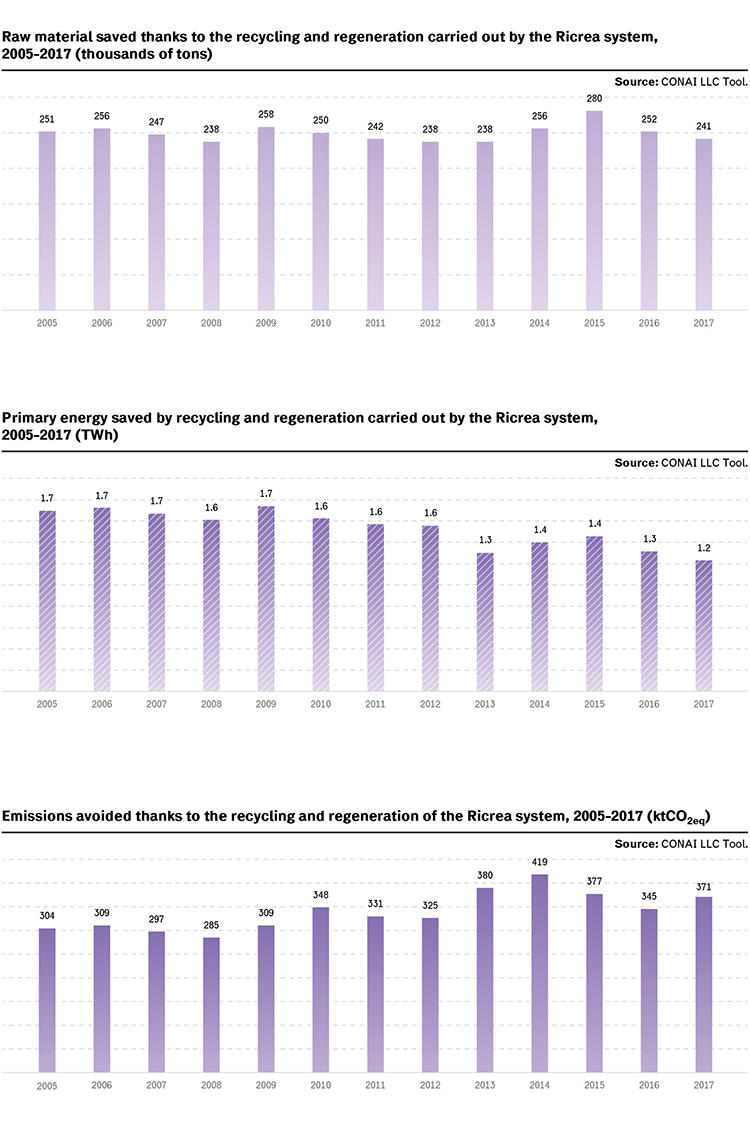
It is possible to estimate the relative direct and indirect economic benefits for the country-system through the LLC Tool from the environmental benefits we just listed. The total economic benefit in 2017 is equal to 44 million euros (+42% compared to 2005). On the whole, the consortium steel packaging waste collection industry has generated an economic value of 513 million euros from 2005 to 2017. It is made up of:
- 383 million euros of direct benefits generated by the consortium steel packaging waste collection industry, represented by the economic value of saved raw material; these benefits have been equal to 33 million euros in 2017 (+50% compared to 2005);
- 131 million euros of indirect benefits referring to the CO2eq emissions avoided thanks to the recycling activities carried out by consortium management; the total for 2017 is 11 million euros (+22% compared to the estimated data for 2005).
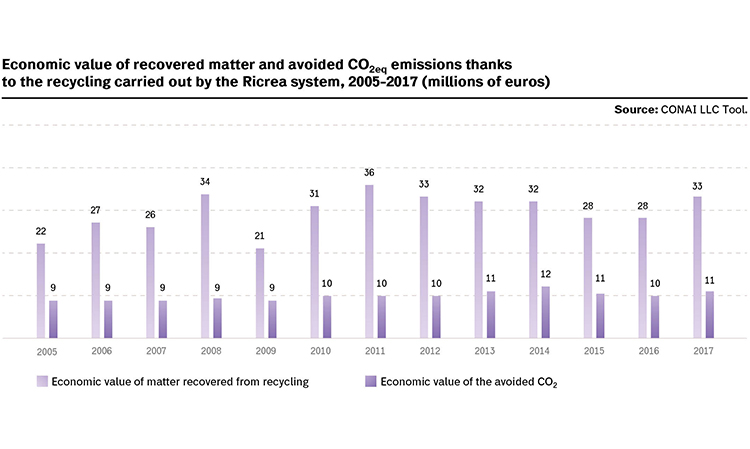
Top image – blickpixel@pixabay_CC0

